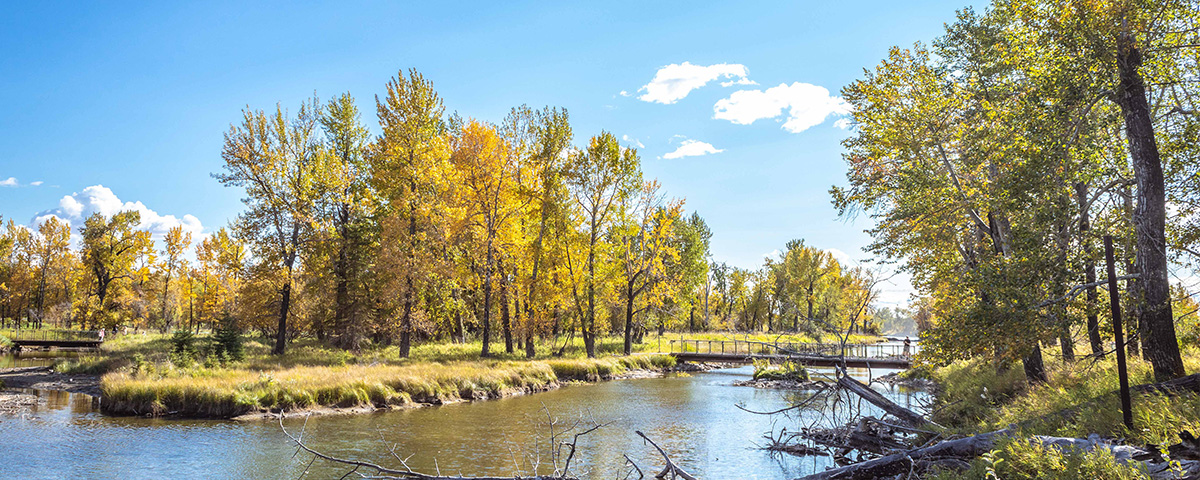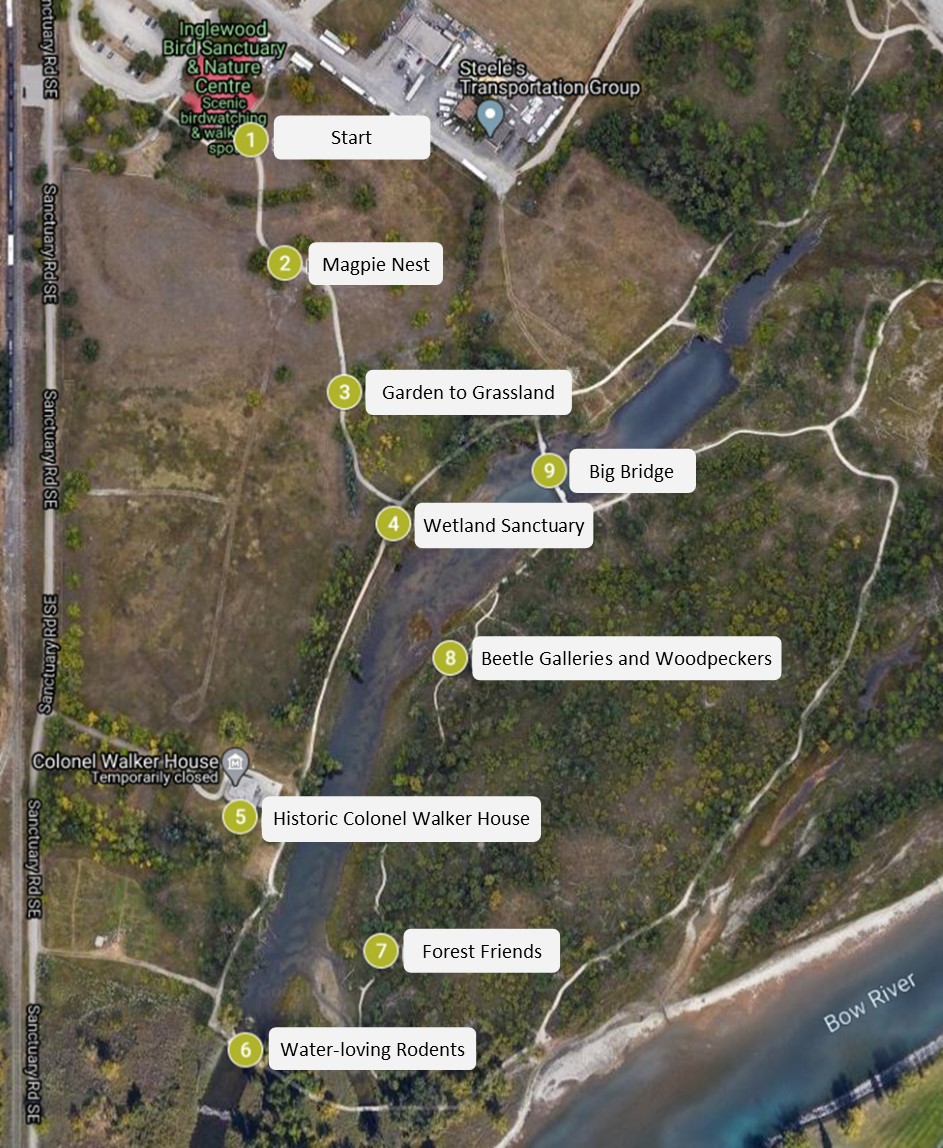Inglewood Bird Sanctuary self-guided walk
Total distance: Approximately 1.5 km
Start location: Behind the Nature Centre
Please be respectful of other park users and follow Parks Bylaws:
- Stay on designated trails
- Do not litter
- Do not disturb or feed wildlife, including birds
- Do not collect plant or animal material
Enjoy your walk!
Stop 1: Start
Walking directions
Head down the main trail to get to the next stop.
Stop 2: Magpie nest
After the little bridge, look to the right to find a stand of choke cherry bushes. If you look carefully, you might see a magpie nest. Magpies are among the first birds to lay their eggs in the spring. This is why their nest looks like a big ball of sticks; it has a roof to keep Calgary’s spring snow away. Magpies are important birds here at the Inglewood Bird Sanctuary. Their particular job is to help clean up — they do this by eating dead things, extra berries, and bugs. They are brilliant and are always learning, so if you see a magpie say hello.
Walking directions
Continue on the trail to get to the next stop.
Stop 3: Beautiful Bowmont
The big grassy field to your right is prairie grassland. It is home to several small brown birds like sparrows, but it is also a good hunting ground for hawks, so check the skies for soaring red-tailed or Swainson’s hawks.
This land didn’t always look like this. It was once a big garden! From the 1930s to the 1950s, several Chinese families had market gardens to grow food and plants for Calgarians. They lived here by their gardens with no heat or running water. Unfortunately, they were forced to leave when the property they were leasing was sold. Now, it is a garden for Savannah sparrows and clay-coloured sparrows to get the food they need.
Walking directions
Continue on the trail and turn right at the T-intersection to reach the next stop.
Stop 4: Wetland sanctuary
The water in front of you is a lagoon, not a river, and its water moves VERY slowly. This means many plants and bugs can grow in the water to help feed the animals. The land across the lagoon is a large section of the sanctuary, almost surrounded by water, with the Bow River on the other side. Having water all around makes this a safe place for many animals. Did you know that Sanctuary means a safe place? This whole park is here to keep wild animals safe. Thank you for helping them to feel secure by staying on the trails and keeping quiet when you see them. Some geese and ducks have their small sanctuaries on the little islands in the lagoon. When they build their nests here, it is hard for coyotes and minks to get to their eggs unseen.
Walking directions
Continue along the main trail to the Brick House.
Stop 5: Historic Colonel Walker House
This big old brick house is known as the Colonel Walker House. It has been here a long time. Do you want to guess how old this house is?
This house was built in 1910, making it 110 years old. It was built by Colonel James Walker and lived in by him and his family. He built this house to be very sturdy and strong because he had some experience with houses being flooded and washed away — this being his third house on the property.
Colonel Walker is an essential figure in Calgary’s history. He came to Alberta in 1882 as an accomplished military man but quickly added to his accomplishments. He was:
- the first Justice of the Peace in Calgary
- the first president of Calgary Exhibition (later Calgary Stampede and Exhibition)
- the owner of the first telephone in Calgary from downtown to the Walker Sawmill at IBS
- the organizer of the first scout and cadet groups in Calgary... the list goes on.
When we think about this park and what it is today, other people have played important roles. Selby Walker was the son of Col. James Walker. Selby loved to go hiking and rock climbing. One day, he was out in the mountains and met a lifelong friend – George Pickering. These two loved nature and are responsible for this land being protected by the Federal government as a Migratory Bird Sanctuary. Because of them, this park has been protecting wildlife and connecting Calgarians with nature for over ninety years.
When the park first opened (1929), George Pickering was the first Superintendent of the Sanctuary. He worked at the Inglewood Bird Sanctuary for free for 15 years until he finally started to be paid for his work. He worked here for 26 years, learning about and protecting wildlife. Pickering was an expert on the local birds. He began banding birds for research and built gardens, walkways, and ponds. He also ran education programs for hundreds of school children.
Much of his work continues today, with the City of Calgary maintaining the property, providing education programs, and conducting research for the Calgary Bird Banding Society. You can walk around the house and lawn; this is an excellent place to see wildlife.
Walking directions
Return to the main trail and turn right (south) to get to the next stop.
Stop 6: Water-loving rodents
This south end of the Sanctuary continues past the fence but has limited access to people as it is a wildlife refuge, or in other words, an extra safe place.
From the first bridge, you can see a dam that helps to keep the lagoon's water levels constant. Although humans built this dam, beavers have maintained it. When beavers hear a trickle of water, they move quickly to plug the hole.
Watch along the trail for trees and shrubs that beavers have chewed. They will chew down a tree for many reasons, building materials, food, and tooth maintenance. Rodents have front teeth that are long and sharp, but they are only sharp because these animals chew on things to sharpen them. These front teeth also grow continuously throughout the animals' life.
This bridge is a good place to see another water-loving rodent: the muskrat. Muskrats are much smaller than beavers, have a skinny tail, and are often out in the middle of the day (unlike beavers, who are crepuscular — active at dawn and dusk).
Take a moment to watch for these water-loving animals.
Turn left at the next intersection to continue on the self-guided walk route.
Walking directions
Continue along the trail. After the second bridge, turn left to get to the next stop.
Stop 7: Forest friends
This next stretch of trail will take you through the forest. Wildlife can be seen at all levels — from the ground to the tops of the trees. This forest is mainly made up of Balsam Poplar trees, and under those trees, there are lots of shrubs that provide food and shelter for animals.
Look carefully through the bushes for deer laying in the shade or snacking on leaves or twigs.
In midsummer, the Saskatoon berry bushes become full of ripe berries. These berries are an important food source for several bird species. Waxwings are beautiful birds with black masks, yellow-tipped tails, and little red waxy nubs on their wings. They love to eat berries like Saskatoons. Listen for their high-pitched trilled sound — when they're not filling up on berries.
Higher up but below the canopy is a good place to look for Great Horned Owls. Their feathers blend in perfectly with the bark of the Balsam Poplar trees, so walk slowly and watch for movement. You can also listen for them and their low hoo hoo hoo hoo hoo.
Walking directions
Continue down the main trail to get to the next stop.
Stop 8: Beetle galleries and woodpeckers
Take a look from the platform to see what wildlife is around, but also take a look at the logs at the platform's entrance. These logs have lots of crazy lines dug into them.
This 'artwork' was created by insects living under the tree bark when these trees were standing. This is a safe place for insects to live as the tree bark protects them, but not everyone! Can you think of a bird that could get to these bugs?
That's right, a woodpecker.
These birds are specially designed to break through the bark with their strong beaks and grab the insects inside with extra-long tongues. Listen as you walk for the gentle tap-tap-tap of a woodpecker looking for food.
Walking directions
Continue down the main trail until you get to the big bridge. Turn left onto the bridge. This is the last stop.
Stop 9: Big bridge
The more time you spend in the Inglewood Bird Sanctuary, the more likely you are to see some of the over 270 species of birds. The big bridge has one of the best vantage points in the whole park. Take a minute to look all around and soak up the beauty of nature.
Walking directions
From this point, you can return to the parking lot (turning left after the bridge, then right at the T-intersection). If you have extra time, there are more trails to explore. Try taking a right after the bridge.



